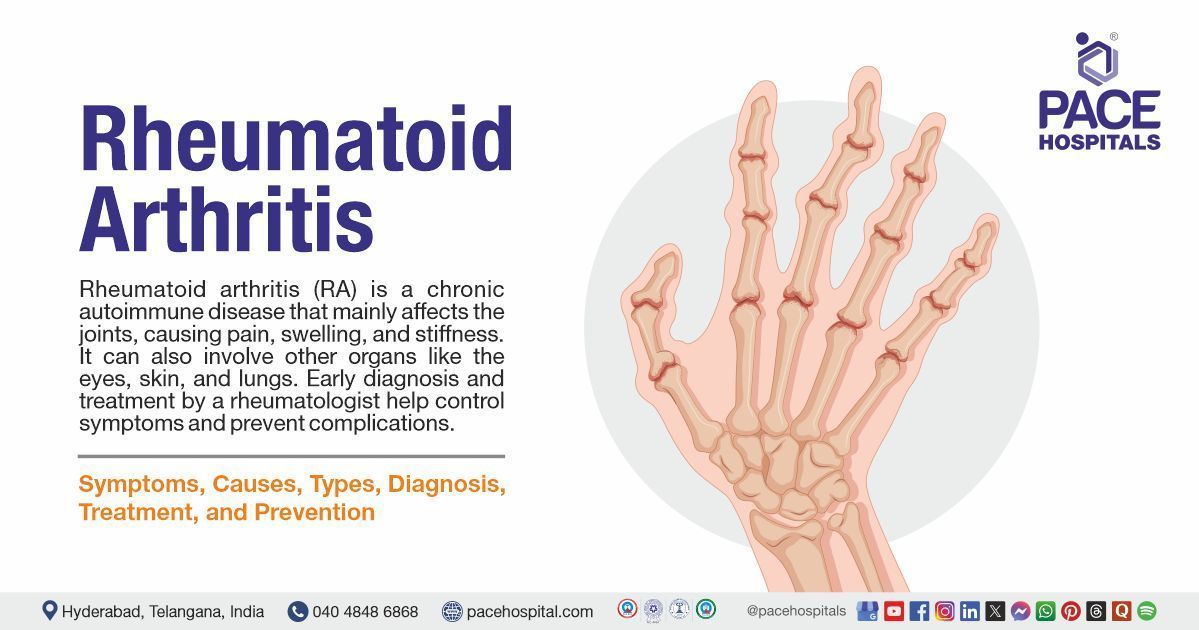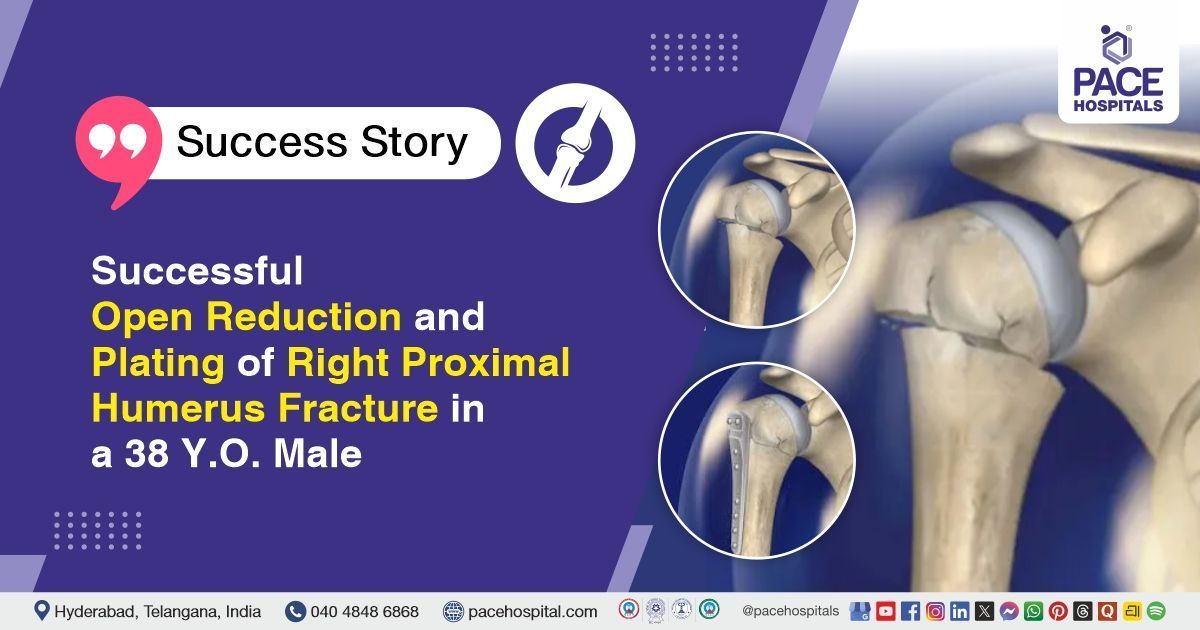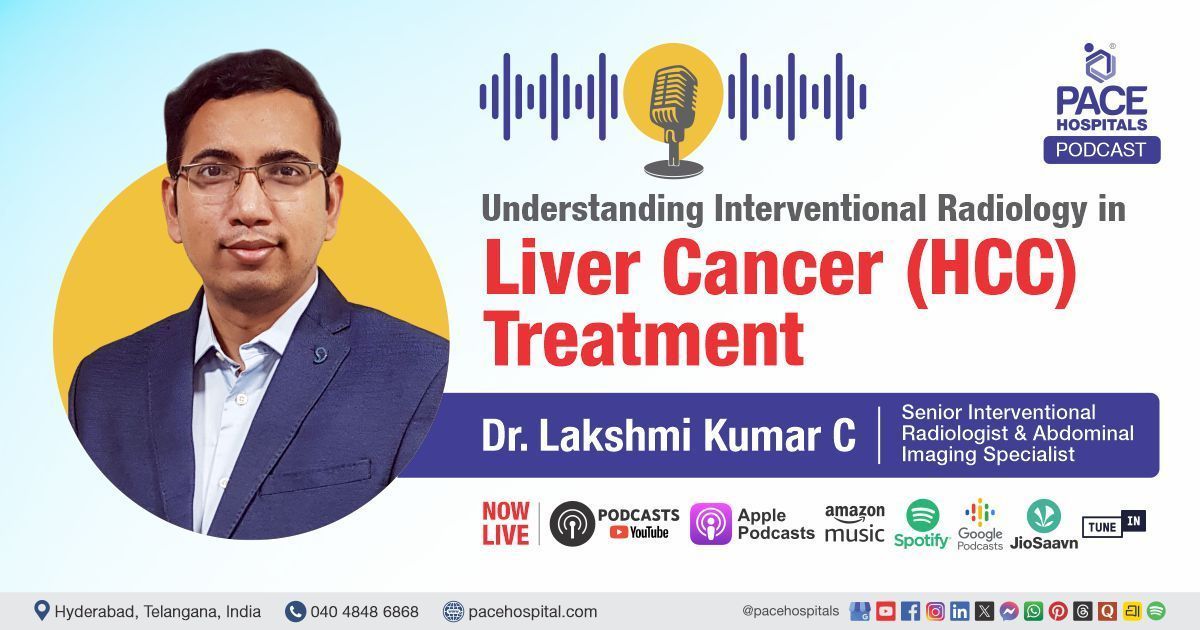Rheumatoid Arthritis - Types, Symptoms, Causes, Diagnosis & Treatment
PACE Hospitals
Overview | Prevalence | Types | Causes | Symptoms | Risk Factors | Complications | Diagnosis | Treatment | Prevention | Arthritis vs Rheumatoid arthritis | FAQs | When to consult a Doctor
Rheumatoid arthritis definition
Rheumatoid arthritis (RA) is a chronic inflammatory autoimmune disease that primarily affects the synovial joints, causing pain, swelling, and stiffness. While RA most commonly involves the wrists and fingers, it can affect any joint and may also cause inflammation in other tissues and organs, such as the eyes, skin, heart, nerves, blood vessels, and lungs.
The disease often begins symmetrically in small peripheral joints and can progress to involve larger joints. Genetic and environmental factors, like smoking, can increase the risk of developing RA. Without proper treatment, persistent inflammation can lead to cartilage destruction, bone erosion, and permanent joint damage. Early diagnosis and management by a rheumatologist can effectively control symptoms and prevent long-term complications.
Rheumatoid arthritis meaning
The name "rheumatoid arthritis" comes from the Greek "Rheuma", meaning "that which flows" or "a flow," and in ancient medicine, it referred to bodily fluids that were thought to flow through the body and cause various diseases. "Arthritis" comes from the Greek words "arthron" (joint) and "-itis" (inflammation), meaning "inflammation of the joint.
The term "rheumatoid" was added to differentiate it from other types of arthritis that were thought to be caused by fluid buildup in the joints.
Rheumatoid Arthritis Prevalence
Rheumatoid Arthritis Global Prevalence
Globally, rheumatoid arthritis affects around 0.21% of the population and is twice as common in women as in men. Although better treatments and more aggressive approaches have improved outcomes, RA still poses a significant financial burden on society. The rates are higher in the U.S. and Northern Europe (0.5–1%). The annual incidence in these regions is about 40 per 100,000 people. Most data come from U.S. and northern European populations, though some groups, like the Pima Native Americans, have rates up to 10 times higher. Women are more affected, with a lifetime risk of 3.6%, compared to 1.7% in men.
Prevalence of Rheumatoid Arthritis in India
Recent estimates suggest that rheumatoid arthritis (RA) affects 0.28% to 0.7% of the Indian population. With a population of approximately 140 crores, this equates to 39 lakh to 98 lakh individuals living with rheumatoid arthritis. It is more prevalent in women, and its incidence rises with age, reaching a peak in older adults. Regional variations exist, with higher prevalence in urban areas and among female populations.
Types of Rheumatoid Arthritis
There are 3 main types of rheumatoid arthritis disease. Seropositive and seronegative (RA) are the two primary forms of rheumatoid arthritis (RA), with juvenile RA being an additional type that only affects children.
The following are the different types of rheumatoid arthritis:
- Seropositive rheumatoid arthritis (RA)
- Seronegative rheumatoid arthritis (RA)
- Juvenile Idiopathic Arthritis (JIA)
Seropositive rheumatoid arthritis (RA)
A person suffering from seropositive rheumatoid arthritis has a positive rheumatoid factor or anti-CCP blood test result. These are antibodies that trick the immune system into attacking the body's cells and tissues. This is considered severe and causes joint damage, deformity, development of vasculitis, lung issues, and rheumatoid nodules.
Seronegative rheumatoid arthritis (RA)
If a person experiences the symptoms of rheumatoid arthritis even after testing negative for anti-CCP and Rheumatoid factors (RF), they might have seronegative RA. Around 20-30 percent of patients may still have RA, even when the test for RA is negative. The body produces antibodies that can still result in symptoms of rheumatoid arthritis, but are not yet routinely measured in the laboratory. However, this type of RA is less severe, and its symptoms usually include joint swelling, morning stiffness, and pain.
Juvenile Idiopathic Arthritis (JIA)
Rheumatoid arthritis (RA) in kids aged 17 and under is referred to as juvenile idiopathic arthritis. Like other types of rheumatoid arthritis (RA), these symptoms may include inflammation, stiffness, fever, rash, and swollen lymph nodes.
Rheumatoid Arthritis Causes
There is no recognized cause of rheumatoid arthritis (RA). Infectious, hormonal, immunological, environmental, and genetic factors are significant contributors to rheumatoid arthritis. The development and outcome of diseases can be influenced by lifestyle, psychological, and socioeconomic variables.
Below are the causes of rheumatoid arthritis:
- Infectious agents
- Genes
- Environment
- Sex hormones
- Immunological factors
Infectious agents: Many infectious pathogens, such as Mycoplasma species, Epstein-Barr virus (EBV), and Rubella virus, have been proposed as possible causes of RA for many years.
Genes: Rheumatoid arthritis is caused by specific genes that affect the immune system's function. Some individuals with these genes, nevertheless, never get the illness. This implies that rheumatoid arthritis is affected by a number of genes. Furthermore, the severity of the disease and who is affected may be influenced by multiple genes.
Environment: Researchers are still investigating how specific genes that also raise a person's risk for developing rheumatoid arthritis can be triggered by environmental variables like cigarette smoke. Furthermore, the development of RA may be influenced by several variables, including inhalation, germs, viruses, lung disease, and gum disease.
Sex hormones: When genetic and environmental factors are combined, researchers believe that sex hormones may contribute to the development of rheumatoid arthritis, and it is more common in women than in men, according to studies. Additionally, the illness could improve during pregnancy and then get worse.
Immunological factors: The autoimmune process of RA is initiated, spreads, and is maintained by all the key immunologic components. T and B cells, antigen-presenting cells (such as B cells, macrophages, and dendritic cells), and different cytokines are all involved in the intricate coordination of the cellular and cytokine activities that result in pathologic outcomes (such as synovial proliferation and subsequent joint degeneration). RA is characterized by abnormal cytokine pathways and the production and regulation of both pro- and anti-inflammatory cytokines.
Rheumatoid Arthritis Symptoms
The wrists, hands, feet, ankles, knees, shoulders, and elbows are the joints most frequently impacted by RA. On both sides of the body, the illness frequently results in inflammation in the same places. The onset of symptoms might be abrupt or gradual. The signs and symptoms of rheumatoid arthritis may differ from person to person.
Common symptoms of rheumatoid arthritis are:
- Stiffness, especially in the morning
- Joint pain at rest and when moving
- Decreased movement
- Bumps over the small joints
- Difficulty with everyday life tasks, including buttoning shirts, opening jars, and tying shoes
- Occasional fever
- Fatigue
- Trouble grasping or pinching things
- Pain is worse with joint movement
- Swelling, tenderness, and warmth over the joints
Rheumatoid Arthritis Risk Factors
Understanding the risk factors for rheumatoid arthritis (RA) is essential for early detection and effective management. These factors shed light on why certain individuals are more susceptible to RA.
Below are some of the risk factors of rheumatoid arthritis:
- Age
- Sex
- Family history and genetics
- Smoking
- Obesity
- Periodontitis
- Lung disease
Age: Although rheumatoid arthritis may strike at any age, the likelihood of getting it rises with age. Juvenile idiopathic arthritis, a disorder linked to rheumatoid arthritis, can be identified in children and young adolescents.
Sex: Women get rheumatoid arthritis more often than men. The condition affects two to three times as many women as men. For certain women, the condition may develop as a result of hormonal and reproductive variables, according to research.
Family history and genetics: The likelihood of developing RA may increase if a family member has already been diagnosed with this condition. Several genetic variables may slightly increase the risk of developing RA.
Smoking: Long-term smokers had a higher chance of developing rheumatoid arthritis, according to research. The illness can be worse for those who continue smoking.
Obesity: According to certain studies, obesity may raise the risk of the condition and reduce its potential for improvement.
Periodontitis: Gum disease may be associated with the development of rheumatoid arthritis (RA).
Lung disease: Diseases of the lungs and airways may also be associated with the development of rheumatoid arthritis (RA).
Complications of Rheumatoid Arthritis
If rheumatoid arthritis is not adequately managed, it may increase the chance of acquiring other complications.
Some of these complications of rheumatoid arthritis include:
- Carpel tunnel syndrome
- Widespread inflammation
- Joint damage
- Cardiovascular disease
- Cervical myelopathy
- Anaemia
Carpel tunnel syndrome: It is common in people with rheumatoid arthritis, and it is caused by compression of the nerve that regulates sensation and movement in the hands (median nerve).
Widespread inflammation: It refers to inflammation that affects multiple parts of the body, not just the joints. In rheumatoid arthritis, this can impact organs like the heart, lungs, skin, and eyes.
- Lungs: Pleurisy or pulmonary fibrosis can result from inflammation of the lungs or lung lining.
- Heart: Pericarditis (Inflammation of the pericardium) can result from inflammation of the tissue around the heart.
- Eyes: Sjögren's syndrome or scleritis can result from inflammation of the eyes. While Sjögren's syndrome might result in dry eyes, scleritis can produce redness and pain in the eyes.
- Vasculitis: It is an inflammation of the blood vessels that causes the walls of the vessels to thicken, narrow, weaken, and scar. In severe situations, it can impair blood flow to the body's tissues and organs, posing a threat to life.
Joint damage: Rheumatoid arthritis can cause serious and irreversible damage to the joints if it is not well managed or treated promptly.
Cardiovascular disease: People with rheumatoid arthritis are at a higher risk of developing cardiovascular disease (CVD).
Cervical myelopathy: Long-term rheumatoid arthritis increases the risk of cervical myelopathy (a condition that affects the top of the spine).
Anaemia: Weakness and exhaustion are symptoms of anaemia, which is often caused by chronic inflammation.
Rheumatoid Arthritis Diagnosis
To diagnose rheumatoid arthritis (RA), a combination of imaging, blood tests, and clinical examinations is typically used to assess joint inflammation and damage. Diagnosis and therapy involve a rheumatologist or an arthritis specialist.
The following are the steps commonly included in the rheumatoid arthritis diagnosis criteria:
- Medical history
- Physical examination
- Laboratory tests
- Rheumatoid factor (RF)
- Anti-cyclic citrullinated peptide antibody (anti-CCP)
- Complete blood count (CBP)
- Erythrocyte sedimentation rate (ESR)
- C-reactive protein (CRP)
- Serum electrolytes
- Liver function tests
- Muscle and autoimmune markers
- Thyroid function tests
- Imaging tests
- X-rays (plain radiographs)
- Magnetic resonance imaging (MRI)and ultrasound
- Computed tomography (CT)scan
- Positron emission tomography (PET) scan
- Bone scan
- Dual-energy X-ray absorptiometry (DEXA)
- Joint aspiration
- Nodule biopsy
Rheumatoid Arthritis Treatment
Rheumatoid arthritis (RA) has no known cure. Reducing pain and inflammation while preserving function is a common goal of therapy. Age, overall health, and symptoms help determine the course of treatment. Additionally, it depends on the severity of the condition.
The following are the treatment options, including:
- Nonpharmacological therapy
- Pharmacological therapy
- Surgical management
Nonpharmacological management
- Patient education
- Physical and occupational therapy
- Lifestyle modifications
Pharmacological management
- Disease-modifying antirheumatic drugs (DMARDs)
- Corticosteroids
- Biologic response modifiers (Tumor necrosis factor (TNF) inhibitors)
- Targeted synthetic DMARDs (Janus Kinase (JAK) Inhibitors)
- Non-steroidal Anti-inflammatory Drugs (NSAIDs)
- Interleukin 6 Inhibitors
Surgical management
- Synovectomy
- Arthroplasty (Total joint replacement)
- Arthrodesis (Joint fusion)
Why Choose PACE Hospitals?
Expert Super Specialist Doctors
Advanced Diagnostics & Treatment
Affordable & Transparent Care
24x7 Emergency & ICU Support
Rheumatoid Arthritis Prevention
Rheumatoid arthritis (RA) cannot be completely prevented; certain lifestyle modifications can help reduce the risk or delay its onset.
The following are the preventive measures for rheumatoid arthritis:
- Proper rest and exercise
- Joint care
- Stress management
- Monitoring of symptoms
- Healthy diet
- Avoid smoking
Proper rest and exercise: Maintaining flexibility, keeping joint mobility, and building strong, healthy muscles all depend on exercise. Rest reduces fatigue, discomfort, and inflammation in active joints. Shorter rest intervals, occasionally, are generally more beneficial than extended bed rest.
Joint care: Splints are mainly used on the hands and wrists. However, they can also be used on the ankles and feet. To reduce pain and swelling. It is recommended to consult a doctor or an occupational therapist before using a splint. Maintaining a healthy weight also helps reduce stress on joints.
Stress management: Living with illness can be more challenging when under stress. The degree of pain experienced may also be impacted by stress.
Monitoring of symptoms: It is essential to track any changes in symptoms or the emergence of new ones. If the pain worsens, a doctor can treat it more effectively if they understand the symptoms and how they are evolving.
Healthy diet: A well-balanced, nutritious diet that provides the correct number of calories, protein, and calcium is essential for maintaining good overall health.
Avoid smoking: It is a significant risk factor for rheumatoid arthritis (RA), especially for seropositive RA, which is marked by the presence of specific antibodies. It increases the production of citrullinated proteins, potentially triggering an autoimmune response.
Difference Between Arthritis and Rheumatoid Arthritis
Arthritis vs Rheumatoid arthritis
Rheumatoid arthritis is a specific, long-term autoimmune disease, whereas arthritis is a general term for inflammation of the joints that encompasses a variety of conditions. Below are some of the parameters that help in differentiating arthritis and rheumatoid arthritis:
| Parameters | Arthritis | Rheumatoid arthritis |
|---|---|---|
| Definition | Inflammation of one or more joints is commonly referred to as arthritis. It encompasses more than 100 distinct types of joint disorders and ailments, which can result in stiffness, oedema, and pain. | In RA, a particular autoimmune disease and form of inflammatory arthritis, the immune system unintentionally targets the synovium, the lining of the joints, causing persistent inflammation and joint destruction. |
| Affected joints | It depends on the kind. Weight-bearing joints, including hips, spine, and knees, are commonly affected by osteoarthritis. Other types may have varying effects on different joints. | Hands, wrists, and feet are among the minor joints that RA typically affects first. On both sides of the body, it usually affects symmetrical joints. |
| Systemic Involvement | The majority are restricted to joints. Some autoimmune diseases can impact other organs, such as lupus arthritis. | Systemic nature, RA can impact the heart, lungs, blood vessels, skin, and eyes, among other organs. |
| Progression | Because of joint damage, osteoarthritis develops gradually over the years. The progression of other types may differ. | In its early stages, RA frequently develops quickly and can lead to joint deformities and disability if left untreated. |
Frequently Asked Questions (FAQs) on Rheumatoid Arthritis (RA)
Is rheumatoid arthritis genetic?
Yes, rheumatoid arthritis (RA) can run in families, and genetics are estimated to account for about 40–60% of the risk of developing the disease. However, having a genetic predisposition does not guarantee people will get RA, as environmental factors like smoking, infections, and lifestyle choices also play a crucial role in triggering the disease. Most cases of RA result from a combination of genetic susceptibility and environmental influences.
Does rheumatoid arthritis affect pregnancy?
Yes, rheumatoid arthritis (RA) can interfere with pregnancy, but many RA patients have safe pregnancies and newborns, particularly when their RA is adequately treated. Nonetheless, women with RA may be more susceptible to specific problems, such as low birth weight, premature birth, and cesarean sections. There are differences in how RA affects pregnancy; some women may have flare-ups, while others may have a decrease in symptoms.
Is rheumatoid arthritis serious?
Yes, Rheumatoid arthritis (RA) is a severe autoimmune disease that can lead to long-term disability. It develops when the immune system unintentionally targets the joints, causing inflammation, pain, stiffness, and swelling. Without proper treatment, RA can result in permanent joint damage and may also affect other organs, reducing overall health and quality of life.
Why does rheumatoid arthritis occur?
A misdirected immune system attack against the body's tissues, particularly the joint lining, is the cause of rheumatoid arthritis (RA). In addition to causing pain, stiffness, and inflammation in the afflicted joints, this inflammatory reaction may also harm bones, cartilage, and other tissues. Although the precise reason is yet unknown, environmental factors and genetic predisposition are thought to be involved.
How to reverse rheumatoid arthritis?
Although joint damage cannot be reversed in rheumatoid arthritis (RA), remission is possible with proper treatment and management. With early and proactive treatment, including medications such as disease-modifying antirheumatic drugs (DMARDs) and biologics, along with lifestyle modifications, the progression of joint damage can be slowed, and long-term complications can be prevented.
How do you cure rheumatoid arthritis permanently?
There is no permanent cure for rheumatoid arthritis (RA). However, early and comprehensive management, including medication, lifestyle modifications, physical therapy, and, when necessary, surgery, can significantly reduce symptoms, improve quality of life, and lower the risk of long-term joint damage.
How do you diagnose rheumatoid arthritis early?
Rheumatoid arthritis is often challenging to diagnose because joint stiffness and inflammation can result from many different conditions, and there is no single definitive test. Diagnosis involves a combination of clinical signs, blood tests, and imaging, with the anti-CCP test being crucial for early detection.
Which is worse, rheumatoid arthritis or osteoarthritis?
Rheumatoid arthritis (RA) and osteoarthritis are both serious. Still, RA is generally considered more severe because it is a systemic autoimmune disease that can cause widespread inflammation and damage to joints and other organs. OA is a degenerative joint disease that mainly affects cartilage. The severity of the disease depends on the individual case, but RA has a higher risk of disability and systemic complications.
Is rheumatoid arthritis an autoimmune disease?
Rheumatoid arthritis (RA) is a chronic (long-lasting) autoimmune disease that primarily affects the joints. RA occurs when the immune system compromises the body's natural defence against illness and infection. Joint discomfort, stiffness, swelling, and loss of function are all symptoms of the condition.
What are the four stages of rheumatoid arthritis?
Rheumatoid arthritis (RA) is categorized into four stages:
- Stage 1: with no joint damage on X-rays.
- Stage 2: Osteoporosis and bone destruction, no deformity. Stage
- Stage 3: Cartilage and bone destruction, deformity, and osteoporosis.
- Stage 4: Bony or fibrous ankylosis with Stage 3 features.
Why are females more likely to get rheumatoid arthritis?
Rheumatoid arthritis (RA) is two to three times more common in women than in men, and this difference is strongly linked to sex hormones. Research shows that autoimmunity is influenced by genetics, and genes on the sex chromosomes may help explain why RA is more common in women. Estrogen, a key female hormone, is believed to affect the immune system by allowing harmful immune cells to survive, which may increase the risk of autoimmune diseases like RA in women
How to control rheumatoid arthritis?
Pharmacologic and nonpharmacologic therapy are both part of an integrated approach to rheumatoid arthritis (RA) patient care. There are numerous nonpharmacologic treatments for this illness, such as physical therapy, counselling, stress management, massage, exercise, diet, and surgery. Explaining the reasoning behind the therapies employed and actively including the patient and family in the planning and execution of the treatment plan both improve morale and enhance adherence to the treatment plan.
Is rheumatoid arthritis a fatal disease?
Although rheumatoid arthritis (RA) cannot directly cause death, it can shorten life expectancy because of the higher risk of complications and comorbidities such as lung disease, heart disease, and other illnesses. Although RA is not fatal to individuals, its systemic effects and persistent inflammation can often lower life expectancy by three to ten years.
Can a blood test detect rheumatoid arthritis?
Yes, blood tests play an essential role in diagnosing rheumatoid arthritis (RA), although no single test can confirm the condition on its own. They help detect signs of inflammation, autoimmune activity, and specific markers associated with rheumatoid arthritis (RA). They are used in conjunction with physical examinations and imaging studies to support an accurate diagnosis.
When to consult a doctor for rheumatoid arthritis?
Consult a doctor for rheumatoid arthritis when joint pain, stiffness, or swelling continues for several weeks or begins to interfere with everyday activities.
Warning signs that need attention include:
- Persistent morning stiffness in joints
- Warmth, redness, or swelling around joints
- Joint pain on both sides of the body
- Fatigue, low-grade fever, or unexplained weight loss
If these symptoms do not improve or become worse, a rheumatoid arthritis doctor should be consulted for proper diagnosis and care. Immediate medical attention is advised if pain appears suddenly, becomes very severe, or occurs with high fever. A rheumatologist can provide the most effective rheumatoid arthritis treatment to relieve symptoms, slow the disease, and protect joint health.
Share on
Request an appointment
Fill in the appointment form or call us instantly to book a confirmed appointment with our super specialist at 04048486868











